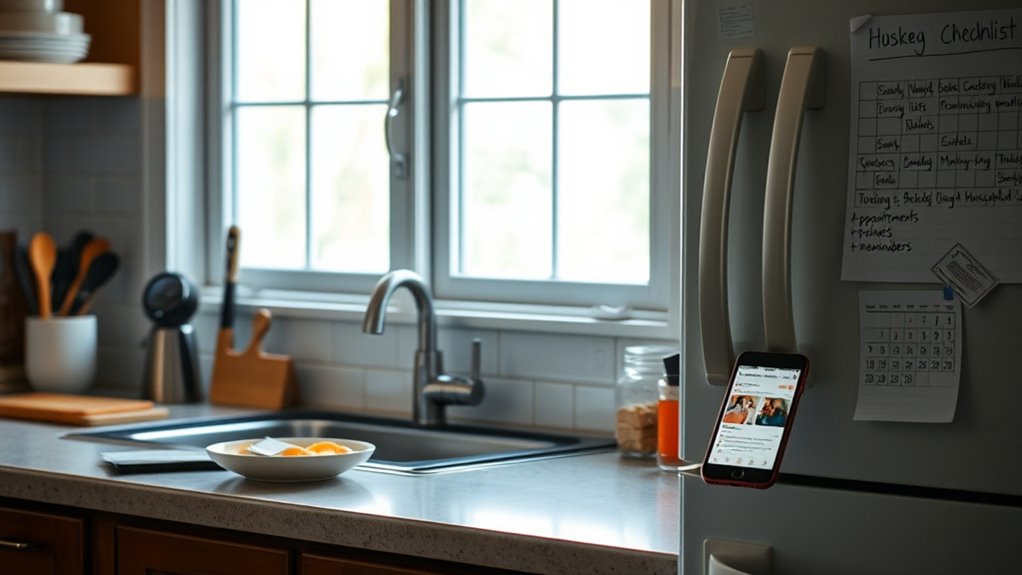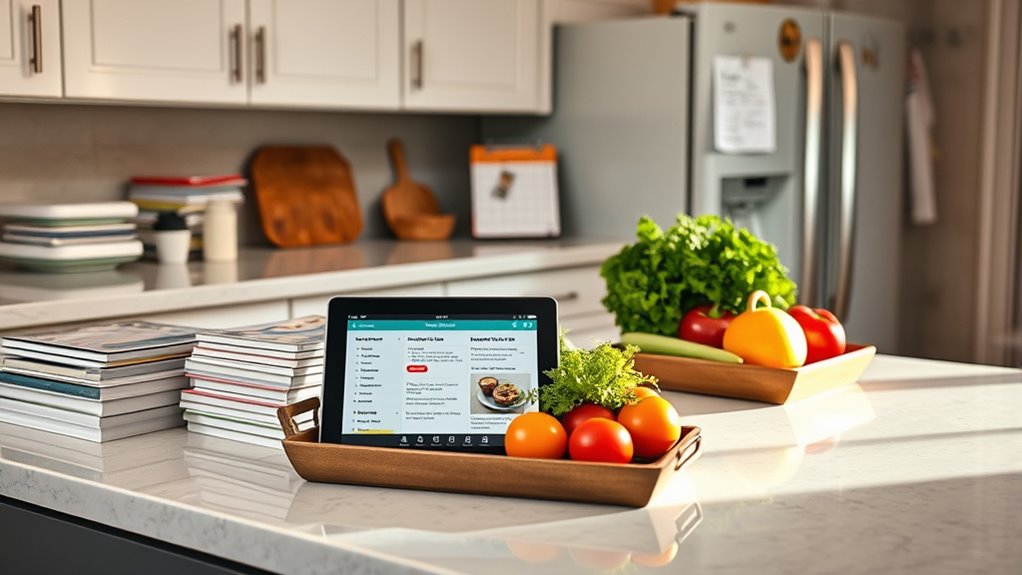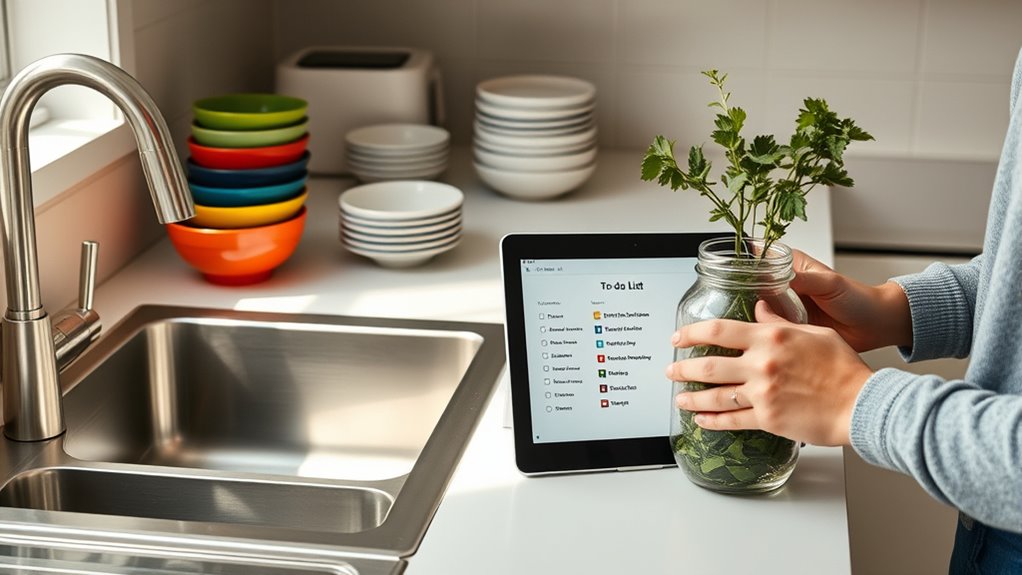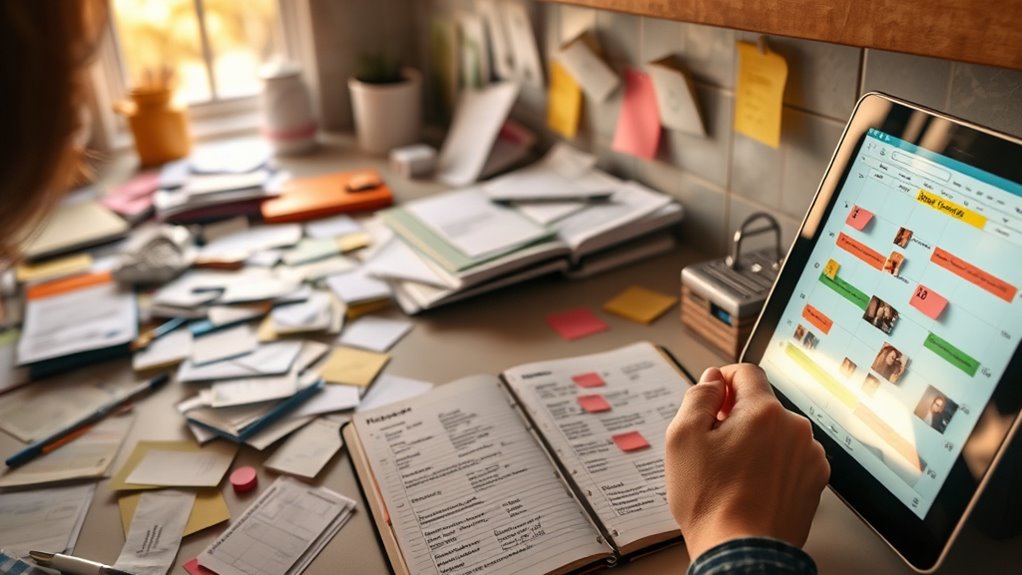An invisible household tasks audit helps you recognize and organize the mental load you carry daily. Start by listing routine chores, managing schedules, and emotional responsibilities that often go unnoticed. Categorize who is responsible for each task and assess if the workload feels fair. Use journals or apps to track efforts over time. Fairly sharing responsibilities reduces stress and promotes balance. Continue exploring ways to create an equitable household environment and manage this ongoing mental effort more effectively.
Key Takeaways
- Create a detailed inventory of household tasks, including routine chores, planning, and emotional responsibilities.
- Track the frequency, duration, and mental effort involved in each task to identify hidden workload patterns.
- Assign ownership and clarify responsibilities using shared calendars or task lists to promote fairness.
- Regularly review and discuss responsibilities to ensure equitable distribution and address any imbalances.
- Maintain ongoing mental load journals to capture emotional and cognitive efforts, facilitating better communication and delegation.
Understanding the Concept of Mental Load

Mental load refers to the invisible mental effort involved in managing daily tasks, responsibilities, and planning that often goes unnoticed. It’s the constant mental checklist you carry, thinking ahead about what needs to be done, remembering appointments, and organizing household chores. This load doesn’t just involve completing tasks; it’s about constantly anticipating needs and coordinating efforts, often without acknowledgment. You might find yourself mentally juggling multiple responsibilities, feeling overwhelmed even when there’s no obvious workload. Recognizing mental load is vital because it highlights the unseen effort many people manage daily. Understanding this concept helps you realize that mental effort isn’t always visible or measurable, but it has a real impact on your well-being and stress levels. Additionally, some tasks may have high forsale 100 importance but low visibility, making them easy to overlook.
Identifying Common Invisible Tasks in Your Household

Many household tasks fly under the radar because they happen consistently without direct oversight. These are the chores you might not notice because they become routine, like remembering to buy school supplies, scheduling appointments, or tracking household supplies. You may also overlook tasks like coordinating family schedules, managing bills, or planning meals. These invisible tasks often require mental effort and organization but lack obvious physical evidence. Recognizing them involves paying attention to the small, repeated actions that keep your household running smoothly. Think about what you do daily without thinking—packing lunches, restocking toiletries, or reminding family members of commitments. An awareness of emotional alignment can help you better understand how your mental load influences your overall well-being. Identifying these tasks helps you see the full scope of your mental load, making it easier to balance responsibilities and seek support.
Creating a Personal Household Tasks Inventory

To better understand your household responsibilities, start by creating a personal tasks inventory. Write down every task you handle daily, weekly, and monthly, from grocery shopping to paying bills. Be specific—include meal prep, laundry, cleaning, and coordinating appointments. Track how often you perform each task and note any recurring responsibilities that often go unnoticed. This exercise helps reveal the full scope of your exhaustive workload. Using an organized system makes it easier to keep track of various chores and responsibilities. Use a notebook or digital document to keep everything organized and easily update it over time. The goal is to see all your tasks clearly, which can help identify patterns, overlaps, or gaps. Having a comprehensive list makes it easier to evaluate how household duties are distributed and to start conversations about sharing responsibilities more fairly.
Categorizing Tasks: Who Does What?

You need clear task ownership to avoid confusion and make sure responsibilities are shared fairly. When responsibilities aren’t balanced, some household duties get overlooked, increasing mental load for everyone. Identifying who does what helps prevent overlooked duties and creates a more manageable routine. Using tools like task categorization can further streamline household responsibilities and reduce stress.
Task Ownership Clarity
Clear task ownership is essential for managing mental load effectively, as it defines who is responsible for each task and prevents confusion. When everyone knows their specific duties, you avoid duplicate efforts and last-minute surprises. Assigning ownership creates accountability and ensures tasks are completed consistently. It also reduces the mental effort needed to track progress or remind others about responsibilities. To achieve clarity, have open conversations with your household members about who will handle each task. Use lists or shared calendars to clearly designate responsibilities. When roles are clear, you minimize misunderstandings, prevent tasks from falling through the cracks, and make household management more predictable. Additionally, understanding the importance of Gold IRA rollovers can help you plan for long-term financial security, reducing stress about future stability. When roles are clear, you minimize misunderstandings, prevent tasks from falling through the cracks, and make household management more predictable. Ultimately, clear ownership streamlines your daily routines and lightens your mental load, fostering a more organized and less stressful environment.
Shared Responsibilities Balance
Balancing shared responsibilities involves categorizing tasks so everyone knows who handles what. You need to clearly define each person’s duties, whether it’s groceries, laundry, or managing appointments. This prevents confusion and overlaps, ensuring no one feels overwhelmed or taken for granted. Use open conversations to set expectations and adjust responsibilities as needed. Recognize that some tasks may require shared effort, while others can be assigned individually. Establish routines and checklists to keep everyone accountable. When responsibilities are well-balanced, it reduces mental load and promotes fairness. Remember, the goal isn’t perfect division but clarity and cooperation. Communicating openly about who does what creates a more harmonious environment, fostering a sense of teamwork and shared ownership of household tasks. Incorporating wall organization solutions can also streamline task management and improve household order.
Overlooked Household Duties
Have you ever overlooked small household duties that quietly pile up and add to your mental load? These minor tasks, like remembering to replace the lightbulb, checking expiration dates, or organizing school supplies, often go unnoticed. Because they seem insignificant, you might not realize they contribute to your ongoing mental clutter. These duties tend to fall on one person, creating an imbalance and increasing stress. Overlooking them can lead to forgotten appointments, missed deadlines, or last-minute scrambles. Recognizing these hidden chores is essential for sharing responsibilities more fairly. By categorizing and addressing overlooked duties, you ease your mental burden and create a more balanced household. Paying attention to these subtle tasks helps prevent small issues from snowballing into bigger problems. Understanding the importance of task efficiency and proper delegation can significantly reduce this invisible load.
Recognizing Emotional and Cognitive Responsibilities

Recognizing emotional and cognitive responsibilities often requires you to pay close attention to the often unnoticed mental tasks you manage daily. These tasks include remembering important dates, managing family members’ moods, and anticipating needs before they arise. You might find yourself mentally juggling schedules, solving problems, or soothing tensions without realizing it’s part of your mental load. These responsibilities often feel invisible because they’re ongoing and intangible, yet they considerably impact your mental well-being. To recognize them, reflect on moments when you’re mentally preoccupied or emotionally involved beyond physical chores. Acknowledging these tasks helps you understand how much mental energy you invest daily, which is essential for addressing imbalance and advocating for shared responsibilities. Recognizing these unseen efforts is the first step toward managing your overall mental load. Understanding essential oils can offer soothing relief for some of these mental strains, supporting your emotional well-being.
Tracking Task Frequency and Time Investment

Keeping track of your mental and emotional efforts can make a big difference in understanding your overall load. By noting how often you perform household tasks and how much time each takes, you gain clarity on where your effort goes. Use a journal, app, or spreadsheet to record daily chores, errands, and planning activities. Be specific—note tasks like grocery shopping, laundry, or scheduling appointments. Track both frequency and duration to identify patterns, such as tasks that recur weekly or monthly. This process helps you see which responsibilities consume most of your time and mental energy. Over time, you’ll develop a clearer picture of your workload, making it easier to recognize imbalances and plan for more equitable task distribution or necessary adjustments. Incorporating well-being tips can also support managing mental load effectively.
Assessing Fairness and Distribution of Responsibilities

To make certain that responsibilities are fairly shared, it’s important to evaluate how tasks are distributed between all involved parties. Ask yourself if everyone’s workload feels balanced and if each person’s contributions align with their capacity. Look beyond who does what and consider the emotional and mental effort invested, not just the physical tasks. Are chores and planning responsibilities spread evenly? Do both partners feel satisfied with the arrangement? Consider whether some tasks are consistently overlooked or delegated unfairly. Open communication plays a key role here—discuss your observations honestly and listen to each other’s perspectives. By assessing fairness regularly, you can identify imbalances early and foster a more equitable household, ensuring no one feels overwhelmed or undervalued. Recognizing the types of household tasks involved can help clarify responsibilities and promote fairness.
Strategies for Sharing and Delegating Tasks

To effectively share and delegate tasks, you need clear communication about who’s responsible for what. Using shared calendars can help everyone stay on the same page and prevent misunderstandings. Regular check-ins ensure tasks are on track and adjustments are made when needed.
Clear Task Distribution
Effective task distribution requires clear communication and mutual understanding. You need to openly discuss who’s responsible for each task, avoiding assumptions. Be specific about expectations and deadlines, so everyone knows what’s needed and when. It’s helpful to create a shared plan, outlining daily, weekly, and monthly chores. When assigning tasks, consider each person’s strengths and availability to ensure fairness. Regular check-ins prevent misunderstandings and allow adjustments as needed. Remember, sharing responsibilities isn’t just about dividing chores but also about respecting each other’s time and effort. Keep the conversation ongoing, and encourage feedback. Clear task distribution reduces confusion, prevents burnout, and fosters a sense of teamwork, making household management more balanced and less stressful.
Use Shared Calendars
Have you considered how shared calendars can streamline task management and keep everyone on the same page? By using a digital calendar, you can assign specific chores, appointments, and deadlines directly to each person. This visibility reduces misunderstandings and prevents tasks from slipping through the cracks. Make it a habit to update the calendar promptly whenever plans change or new responsibilities arise. Encourage everyone in the household to check it regularly, so no one misses important events or tasks. Color-coding or labels can help distinguish between different types of chores or family members’ responsibilities. Shared calendars foster transparency, accountability, and coordination, ensuring everyone is aware of what needs to be done and when. This simple tool can considerably ease the mental load and create a more organized household.
Regular Check-Ins
Regular check-ins build on the clarity provided by shared calendars, offering a dedicated space to review progress and adjust plans as needed. These conversations keep everyone aligned and prevent misunderstandings about responsibilities. Set aside regular times—weekly or biweekly—to discuss what’s been accomplished and what still needs attention. Use this time to voice concerns, celebrate successes, and delegate new tasks. Keep the tone collaborative and solution-focused, ensuring all voices are heard. Regular check-ins help you identify bottlenecks early and adapt plans to fit changing schedules. By establishing this routine, you create a culture of accountability and shared responsibility. Over time, these conversations reduce mental load by making household management transparent and collective, preventing tasks from falling through the cracks.
Maintaining an Ongoing Mental Load Journal

Keeping track of your mental load can feel overwhelming, but maintaining an ongoing mental load journal helps you stay organized and aware of your responsibilities. Each day, jot down tasks, plans, and worries related to household management. Use a notebook or digital app that’s easy to update regularly. This habit reveals patterns and pinpoint areas where you’re overextended. It also makes it easier to communicate your needs to others by providing concrete examples of your mental burden. Set aside a few minutes daily or weekly for updates, ensuring you don’t forget important details. Over time, your journal becomes a valuable tool to assess your workload objectively and identify tasks you can delegate or eliminate, reducing stress and improving household balance.
Building a Collaborative Household Culture

Creating a shared responsibilities framework helps guarantee everyone knows their tasks and feels accountable. Open communication strategies keep household members connected and prevent misunderstandings. By working together intentionally, you can build a collaborative household culture that eases mental load for everyone.
Shared Responsibilities Framework
How can you foster a household environment where responsibilities are shared fairly and collaboratively? Start by establishing a shared responsibilities framework. This involves clearly defining each person’s tasks and expectations, ensuring everyone understands their role. To make this effective:
- Create a list of household chores and assign them based on skills and preferences.
- Schedule regular check-ins to review responsibilities and adjust as needed.
- Use shared tools like calendars or apps to track who’s responsible for what and when.
This structure promotes transparency, accountability, and fairness. When everyone knows their duties and communicates openly, the mental load becomes less burdensome. A shared responsibilities framework builds trust, reduces misunderstandings, and creates a balanced, cooperative household culture.
Open Communication Strategies
Building a household culture rooted in open communication starts with fostering an environment where everyone feels comfortable sharing their thoughts and concerns. Encourage regular check-ins to discuss household tasks, feelings, and challenges without judgment. Use active listening, showing genuine interest and validating each person’s perspective. Be transparent about your needs and expectations, and invite others to do the same. Set aside time for honest conversations, making it clear that all voices matter. Address conflicts calmly and collaboratively, focusing on solutions rather than blame. Create a safe space where feedback is welcomed and appreciated. When open communication becomes a habit, you build trust, reduce misunderstandings, and cultivate a supportive environment that balances mental loads effectively.
Frequently Asked Questions
How Can I Motivate My Household Members to Share Mental Load Equally?
You can motivate your household members by having an open, honest conversation about the mental load and its impact. Clearly share your feelings and encourage them to express theirs. Set shared goals and create a fair system for tasks. Recognize and appreciate their efforts to build motivation. When everyone feels involved and valued, they’ll be more likely to share the mental load equally.
What Are Effective Ways to Communicate About Invisible Household Tasks?
Talking about invisible household tasks is like shining a flashlight into a dark room—you reveal what’s hidden. Be clear and specific when you communicate, avoiding assumptions. Use “I” statements to express your feelings and needs without blame. Regular check-ins help keep everyone accountable. Encourage open dialogue, listen actively, and acknowledge efforts. This way, you create a safe space where household members feel valued and motivated to share the load.
How Do I Handle Resistance When Delegating Mental Load Responsibilities?
When you face resistance when delegating mental load responsibilities, you should stay calm and assertive. Clearly explain why sharing tasks benefits everyone and reduces stress. Listen to their concerns without judgment and find common ground. Offer specific ways they can help, and acknowledge their efforts. Remember, patience is key—change takes time. Keep the conversation open and focus on teamwork to gradually overcome resistance.
Can Mental Load Tracking Improve Overall Household Organization?
Imagine your household as a busy airport, with flights constantly taking off and landing. Tracking mental load helps you see hidden tasks, like baggage handlers revealing unseen luggage. By keeping a mental or written checklist, you can coordinate better, reduce chaos, and guarantee nothing gets lost. This clarity streamlines household organization, making everyday life smoother and less stressful. You’ll feel more in control, like a skilled air traffic controller managing a bustling terminal.
How Do Cultural Differences Influence Perceptions of Household Responsibilities?
Cultural differences shape how you view household responsibilities, influencing who feels responsible and how tasks are prioritized. In some cultures, household chores are seen as shared duties, while others assign them based on gender roles. These perceptions affect communication and expectations within your household. Recognizing these cultural influences helps you understand diverse approaches, fostering more equitable sharing of tasks and reducing mental load for everyone involved.
Conclusion
By tracking your mental load, you realize just how much invisible work you handle daily. Did you know women often spend nearly twice as much time on household tasks as men? Recognizing and sharing these responsibilities isn’t just fair—it’s essential for your well-being. Keep an ongoing journal, communicate openly, and build a supportive household culture. Taking these steps can lighten your mental load and create a more balanced, happier home for everyone.









